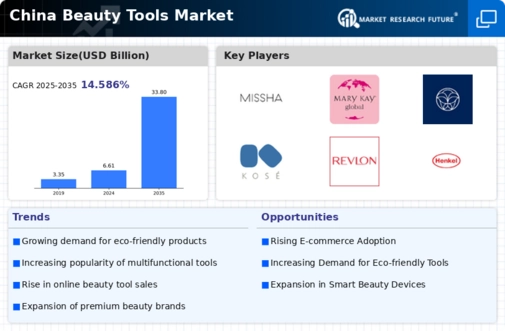The China Beauty Tools Market is a dynamic and rapidly evolving sector characterized by a diverse range of products designed to enhance personal grooming and beauty routines. This market encompasses various tools, including makeup brushes, skincare devices, hair tools, and more, appealing to a growing consumer base that prioritizes both aesthetics and efficacy. With the increasing influence of social media and celebrity endorsements, beauty tools have surged in popularity, driving fierce competition among established multinationals and emerging brands.
The shift towards e-commerce and digital marketing strategies has further intensified rivalries as companies strive for innovation and consumer engagement in a landscape where trends can change overnight. Market players must also navigate the intricacies of consumer preferences and cultural nuances, tailoring their offerings to suit the unique demands of the Chinese market. Missha, recognized for its quality and affordability, holds a strong position within the China Beauty Tools Market. The brand’s competitive edge lies in its ability to deliver innovative products that resonate with younger consumers seeking value without compromising on quality.
Leveraging e-commerce platforms and influencer partnerships, Missha has successfully amplified its reach, making its beauty tools increasingly accessible to a wide audience. The focus on quality materials and practical design has allowed Missha to cultivate a loyal customer base, while its proactive approach to sustainability addresses growing consumer concerns in China. This brand's agility in responding to market trends ensures its continued relevance in a fast-paced industry, positioning it favorably against competitors. Mary Kay is another significant player within the China Beauty Tools Market, known for its comprehensive suite of beauty products, including skincare tools and makeup applicators.
The company has established a notable presence in China, underpinned by a robust direct-selling model that engages a network of independent beauty consultants. Mary Kay's strengths lie in its commitment to empowering women and promoting a personalized beauty experience, which resonates well with Chinese consumers. Through strategic partnerships and localized marketing initiatives, Mary Kay enhances its visibility and reinforces its brand loyalty. The company has also ventured into various mergers and acquisitions to expand its portfolio, further solidifying its foothold in the market.
By focusing on innovative product development and leveraging advanced technologies, Mary Kay continues to adapt to the evolving demands of the China Beauty Tools Market, setting itself apart from competitors.




















